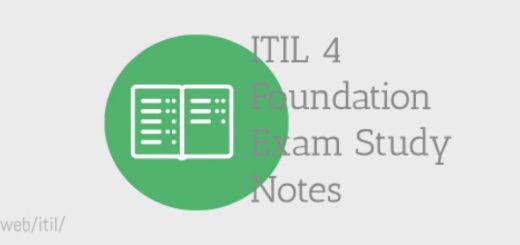ITIL v3 Foundation Certification Notes: Continual Service Improvement

[ITIL® v3 Foundation Notes] Continual Service Improvement affects all stages of service management. It aims to improve the overall service in an organization in a continual manner. The Seven-Step Improvement Process is introduced as the major process for the Continual Service Improvement stage of the ITIL® service lifecycle.
Article Highlights
Service Measurement
- Measurements are critical to the success of continual improvement
- all processes must be measurable in an objective way
- role of measurements:
- assessment of the current status
- identification of improvement areas
- assessment of the improvements made
- types of measurements
- availability
- reliability
- performance
- [definition] Critical Success Factor (CSF) is something that must happen if an IT service, process, plan, process, or other activity is to succeed
- no more than two to five CSFs per process for manageable results
- Key Performance Indicators (KPI) are used to measure whether the critical success factors are achieved
- no more than five KPIs, two to three KPIs in the early stage when maturity level is low
- can be quantitative (e.g. cost) or qualitative (e.g. customer satisfaction)
- check whether a KPI is fit for use – relevant, accurate and useful
- Types of Metrics
- [definition] a metric is a scale of measure that allows you to define what is to be measured
- e.g. percentage reduction of unsuccessful changes, average cost of testing a change
- Technology Metrics – associated with managing service components using monitoring systems, e.g. availability and performance
- Process Metrics – captured in terms of the CSFs and KPIs, to assess quality, performance, value, and compliance of the process
- Service Metrics – a measure of the end-to-end service performance, results from technology and process metrics
Purpose, Objectives and Scope of Continual Service Improvement
- Continually searching for enhancement to improve the whole lifecycle, including CSI for cost saving and enhanced capability
- a closed-loop feedback system, based on the Plan, Do, Check, Act (PDCA) model specified in ISO/IEC 20000, is established and capable of receiving inputs for change from any planning perspective
Purpose of Continual Service Improvement
- to continue to support the business with IT services in response to changing business needs
- including all processes, management, 3rd party suppliers
- to seek ways to improve service effectiveness, process effectiveness and cost effectiveness
Objectives of Continual Service Improvement
- ensure correct and ample measurements are collected from processes
- recommend improvement opportunities by reviewing and analyzing measurements from processes
- review service level achievements by comparing to SLA
- improve the cost effectiveness and efficiency of IT service without affecting the quality
Scope of Continual Service Improvement
- all aspects of the service lifecycle, from strategy through design, transition, and operation
- overall health of IT service management
- alignment of IT services to business development by measuring values of CSI and conducting customer satisfaction survey
- maturity and capability of the organization and people by carrying out maturity assessments and compliance audit
- continual improvement of all aspects
ITIL® Continual Service Improvement Approach
- Identify the vision that drives the improvement initiative – alignment with business strategies
- Objective assessment of the current state – baseline of business, people, process and technology
- baseline is verified snapshot of the environment at a particular time
- baseline is to be captured at regular intervals
- Identify an achievable target – better in smaller steps
- Identify actions to meet the target – process / technology improvement, staff training, etc.
- Measure the achievements – review whether targets are met with measurements like maturity matrix
- Keep on improving
Output of Continual Service Improvement
- CSI Registry
- record all individual improvements as improvements may be made concurrently
- is a service asset managed by the service knowledge management system (SKMS)
- includes: ID, Relative size, Timescale, Description, Priority, KPI metric and Justification
- Improvement Program Documentation
Deming Cycle (PDCA Cycle)
- proposed by W. Edwards Deming
- Plan – planning the activity for improvement (define metrics and measurements) (for governance control)
- Do – implementing a new project for improvement initiatives
- Check – checking and reviewing results of the improvement through measurements
- Act – implementing modifications / corrective actions to the actual process and to determine whether a new project is needed
Seven-Step Improvement Process
- While these seven steps appear to form a circular set of activities, in fact, they constitute a knowledge spiral.
- Purpose
- to define and manage the steps required to implement improvements successfully
- identify and define the measurements and metrics
- gather, analyze and report the data
- manage the implementation
- to define and manage the steps required to implement improvements successfully
- Objectives
- identify improvement opportunities in cost and quality with financial justification (a business case if more complex)
- identify the measurements and metrics
- continually review services to ensure they are aligned with business objectives
- Scope
- analyze performance and capabilities throughout the lifecycle (maturity)
- make the best use of latest technology
- improve organizational structures
Seven Steps (DIKW Model)
- Identify the Strategy for Improvement (Wisdom)
- establish the overall vision for the business – how to best benefit the business?
- all initiatives being considered are entered into CSI register
- Define What You Will Measure (Data)
- confirm a finalized improvement measurement plan with service strategy and service design
- perform gap analysis to identify improvements
- Gather the Data (Data)
- monitor and capture exceptions, resolutions and trends with the data
- Process the Data (Information)
- process data into information (analyzed in context)
- Analyze the Information and Data (Knowledge)
- understand the trend in data and the reasons behind
- compare data to KPIs and targets
- Present and Use the Information (Knowledge)
- present in the correct format with the appropriate details according to audience types:
- customers – meet targets?
- senior IT management – CSFs and KPIs
- internal IT – KPIs to help planning improvements
- suppliers – KPIs of their own services
- present in the correct format with the appropriate details according to audience types:
- Implement Improvement (Wisdom)
- implement the improvement (including submitting a business base if required)
- a new baseline is established after the improvement and the whole cycle begins anew
Conclusion: ITIL® v3 Foundation Continual Service Improvement
This ITIL® v3 Foundation study note touches upon the definition, purpose, objectives and scope of Continual Service Improvement. The Seven-Steps Improvement Process is introduced together with the Deming Cycle (Plan-Do-Check-Act), the DIKW model as well as measurement.
This is the last part of the series of ITIL® Foundation study notes. I have also published an article on last minute ITIL® Foundation revision notes for the exam by extracting all the essential bits from all of the notes in this series. I personally brought the last minute notes to the exam centre for really last minute revision.





 Hi, my name is Edward Chung, PMP, PMI-ACP®, ITIL® Foundation. Like most of us, I am a working professional pursuing career advancements through Certifications. As I am having a full-time job and a family with 3 kids, I need to pursue professional certifications in the most effective way (i.e. with the least amount of time). I share my exam tips here in the hope of helping fellow Certification aspirants!
Hi, my name is Edward Chung, PMP, PMI-ACP®, ITIL® Foundation. Like most of us, I am a working professional pursuing career advancements through Certifications. As I am having a full-time job and a family with 3 kids, I need to pursue professional certifications in the most effective way (i.e. with the least amount of time). I share my exam tips here in the hope of helping fellow Certification aspirants!






Are there courses that teach metrics?
I have been tasked to measure network operations center (NOC) performance. Thanks
Sorry, the ITIL Foundation courses just teach the theory. Maybe you have to search the internet for the right course. Thanks!